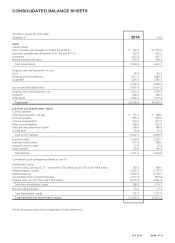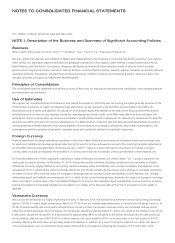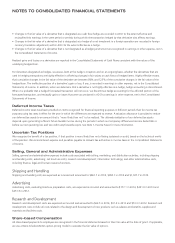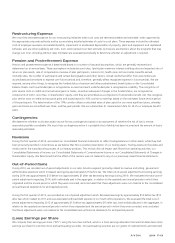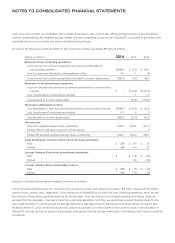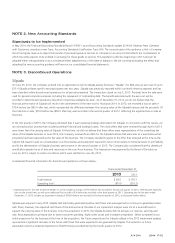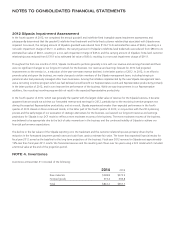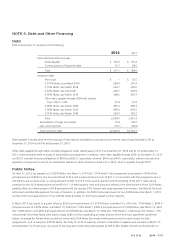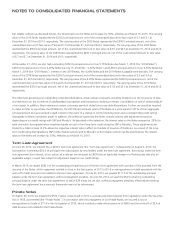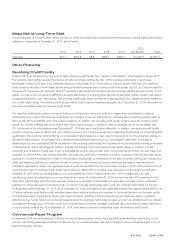Avon 2014 Annual Report Download - page 86
Download and view the complete annual report
Please find page 86 of the 2014 Avon annual report below. You can navigate through the pages in the report by either clicking on the pages listed below, or by using the keyword search tool below to find specific information within the annual report.NOTES TO CONSOLIDATED FINANCIAL STATEMENTS
• Changes in the fair value of a derivative that is designated as a cash flow hedge are recorded in AOCI to the extent effective and
reclassified into earnings in the same period or periods during which the transaction hedged by that derivative also affects earnings.
• Changes in the fair value of a derivative that is designated as a hedge of a net investment in a foreign operation are recorded in foreign
currency translation adjustments within AOCI to the extent effective as a hedge.
• Changes in the fair value of a derivative that is not designated as a hedging instrument are recognized in earnings in other expense, net in
the Consolidated Statements of Income.
Realized gains and losses on a derivative are reported in the Consolidated Statements of Cash Flows consistent with the nature of the
underlying hedged item.
For derivatives designated as hedges, we assess, both at the hedge’s inception and on an ongoing basis, whether the derivatives that are
used in hedging transactions are highly effective in offsetting changes in fair values or cash flows of hedged items. Highly effective means
that cumulative changes in the fair value of the derivative are between 80% and 125% of the cumulative changes in the fair value of the
hedged item. The ineffective portion of a derivative’s gain or loss, if any, is recorded in earnings in other expense, net in the Consolidated
Statements of Income. In addition, when we determine that a derivative is not highly effective as a hedge, hedge accounting is discontinued.
When it is probable that a hedged forecasted transaction will not occur, we discontinue hedge accounting for the affected portion of the
forecasted transaction, and reclassify gains or losses that were accumulated in AOCI to earnings in other expense, net in the Consolidated
Statements of Income.
Deferred Income Taxes
Deferred income taxes have been provided on items recognized for financial reporting purposes in different periods than for income tax
purposes using tax rates in effect for the year in which the differences are expected to reverse. A valuation allowance is provided to reduce
our deferred tax assets to an amount that is “more likely than not” to be realized. The ultimate realization of our deferred tax assets
depends upon generating sufficient future taxable income during the periods in which our temporary differences become deductible or
before our net operating loss and tax credit carryforwards expire. See Note 7, Income Taxes for more information.
Uncertain Tax Positions
We recognize the benefit of a tax position, if that position is more likely than not of being sustained on audit, based on the technical merits
of the position. We record interest expense and penalties payable to relevant tax authorities in income taxes in the Consolidated Statements
of Income.
Selling, General and Administrative Expenses
Selling, general and administrative expenses include costs associated with selling; marketing; and distribution activities, including shipping
and handling costs; advertising; net brochure costs; research and development; information technology; and other administrative costs,
including finance, legal and human resource functions.
Shipping and Handling
Shipping and handling costs are expensed as incurred and amounted to $861.7 in 2014, $990.1 in 2013 and $1,027.7 in 2012.
Advertising
Advertising costs, excluding brochure preparation costs, are expensed as incurred and amounted to $177.1 in 2014, $201.9 in 2013 and
$251.3 in 2012.
Research and Development
Research and development costs are expensed as incurred and amounted to $62.5 in 2014, $67.2 in 2013 and $73.3 in 2012. Research and
development costs include all costs related to the design and development of new products such as salaries and benefits, supplies and
materials and facilities costs.
Share-based Compensation
All share-based payments to employees are recognized in the financial statements based on their fair value at the date of grant. If applicable,
we use a Black-Scholes-Merton option-pricing model to calculate the fair value of options.





